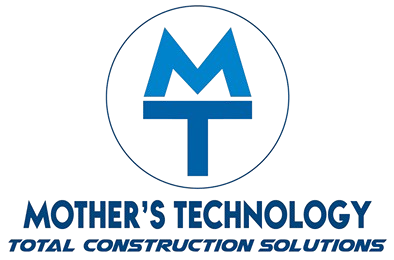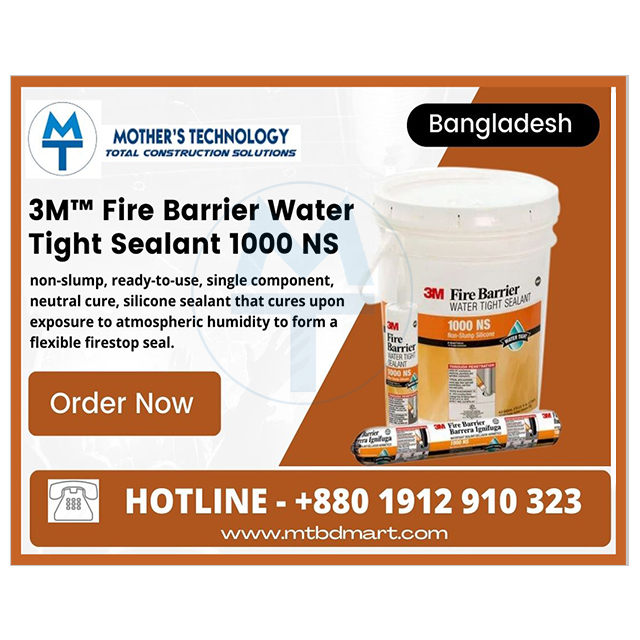Description
3M Fire Barrier Water Tight Sealant 1000 NS – Price in Bangladesh
3M Fire Barrier Water Tight Sealants 1000 NS and 1003 SL are ready-to-use, single component, neutral cure, silicone sealants that cure upon exposure to atmospheric humidity to form a flexible firestop seal. 3M Fire Barrier Water Tight Sealants help control the spread of fire, smoke and noxious gasses before, during and after exposure to a fire when installed in accordance with a listed through penetration or fire-resistive joint assembly.
3M Fire Barrier Water Tight Sealant 1000 NS is a non-slump firestop used primarily on vertical surfaces while 3M Fire Barrier Water Tight Sealant 1000 SL is a self-leveling firestop ideal for floor applications. These firestop sealants also meets UL Water Leakage Test, W Rating — Class 1 requirements for systems tested and listed in accordance with ANSI/UL 1479. Both products are elastomeric, are ready-to use and exhibit excellent weatherability
USES:
3M Fire Barrier Watertight Sealant 1000NS and 3M Fire Barrier Water Tight Sealant 1000 NS are used to firestop blank openings, dynamic and static construction joints and the following penetrating items that pass through fire-rated floor or wall assemblies: metallic pipes, non-metallic pipes, cables, cable tray, insulated pipes, combos and other miscellaneous mechanical penetrations. For vertical firestop applications use 3M Fire Barrier Water Tight Sealant 1000 NS (non-slump) and for horizontal applications use 3M Fire Barrier Water Tight Sealant 1000 NS (self-leveling).
Packaging:
Packaging: Product packaged in cartridge or pail is enclosed in HDPE plastic containers, sausage is packaged in aluminum foil wrap.
Storage: 3M Fire Barrier Water Tight Sealants should be stored indoors in dry conditions between 40°F and 90°F (4°C and 32°C). Avoid repeated freeze/thaw exposures of the 3M Fire Barrier Water Tight Sealants while still in the packaging.
Shelf Life: 3M Fire Barrier Water Tight Sealant 1000 NS and 1003 SL shelf life is 18 months in original unopened containers from date of packaging when stored between 40°F and 90°F (4°C and 32°C). Normal stock rotation is recommended. Lot numbering: First to sixth digit = Date of Production (MMDDYY), Seventh indicator = dash symbol (-), Eighth digit = shift number
Installation Techniques
Preparatory Work: The surface of the opening and any penetrating items should be clean and free of dirt and debris to allow for the proper adhesion of 3M™ Fire Barrier Water Tight Sealant. Do not use alcohol to clean surfaces in penetration or joint opening, instead use a commercial solvent such as mineral spirits, xylene, toluene or methyl ethyl ketone (MEK). Ensure that the surface of the substrates are not wet and are frost free. Sealant can be installed with a standard caulking gun, pneumatic pumping equipment or it can be easily applied with a putty knife or trowel.
Installation Details: Install the applicable depth of backing material, if required, as detailed within the applicable UL, cUL, ULC, Intertek or other third-party listed system. Cut the end of the 3M™ Fire Barrier Water Tight Sealant tube spout to achieve the desired bead width. Install the applicable depth of 3M™ Fire Barrier Water Tight Sealant into the opening flush with the surface of the substrate, or as detailed within the applicable listed system, at the required depth for the assembly and rating that is specified. Tool within 5 minutes. Clean all tools immediately after use with a commercial solvent such as mineral spirits, xylene, toluene or methyl ethyl ketone (MEK).
Limitations: Do not apply 3M Fire Barrier Water Tight Sealants 1000 NS or 1003 SL (Note: once applied,sealant may be exposed to intermittent water — exhibits excellent weatherability when fully cured) or frost-coated, in unvented spaces where sealant is not exposed to atmospheric moisture, in areas where abrasion or physical abuse of the sealant are likely and/or where painting of sealant is required. Do not apply 3M Fire Barrier Water Tight Sealants 1000 NS or 1003 SL to polycarbonates or to building materials that bleed oil, plasticizers or solvent (e.g. impregnated wood, oil-based sealants, or green or partially vulcanized rubber).
Note: In confined cure conditions there may be discoloration of brass, copper or other sensitive metals



Reviews
There are no reviews yet.